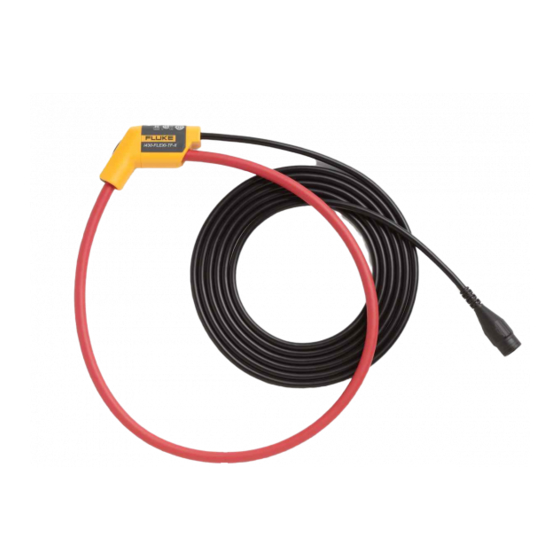
Advertisement
Introduction
The i430-Flexi-TF-II (the Probe or Product) is a flexible AC current probe
for use with the Fluke 430 series I and II Power Quality Analyzers and
other dedicated test tools. The i430-Flexi-TF-II is optimized for current
measurement on thick and hard to reach conductors. Check the user
documentation of your test tool for compatibility before you use this
current sensor.
Available versions are:
•
i430-Flexi-TF-II
•
i430-Flexi-TFII-48
Contacting Fluke
To contact Fluke, call one of the following telephone numbers:
•
Technical Support USA: 1-800-44-FLUKE (1-800-443-5853)
•
Calibration/Repair USA: 1-888-99-FLUKE (1-888-993-5853)
•
Canada: 1-800-36-FLUKE (1-800-363-5853)
•
Europe: +31 402-675-200
•
Japan: +81-3-6714-3114
•
Singapore: +65-6799-5566
•
Anywhere in the world: +1-425-446-5500
Or, visit Fluke's website at www.fluke.com.
To register your product, visit http://register.fluke.com.
To view, print, or download the latest manual supplement, visit
http://us.fluke.com/usen/support/manuals.
To locate an authorized service center, go to www.fluke.com.
PN 4426307 (4822 872 30932 – Rev.3)
December 2011, Rev.3, 9/15
© 2011-2015 Fluke Corporation. All rights
reserved. Specifications are subject to change
without notice. All product names are
trademarks of their respective companies.
i430-Flexi-TF-II
6000 A Flexible
AC Current Probe
61 cm (24 inch)
122 cm (48 inch)
Instructions
Advertisement
Table of Contents

Summary of Contents for Fluke i430-Flexi-TF-II
- Page 1 Introduction The i430-Flexi-TF-II (the Probe or Product) is a flexible AC current probe for use with the Fluke 430 series I and II Power Quality Analyzers and other dedicated test tools. The i430-Flexi-TF-II is optimized for current measurement on thick and hard to reach conductors. Check the user documentation of your test tool for compatibility before you use this current sensor.
- Page 2 Safety Read this section carefully. It will familiarize you with the most important safety instructions for handling the Product. A Warning identifies hazardous conditions and procedures that are dangerous to the user. A Caution identifies conditions and procedures that can cause damage to the Product or the equipment under test.
- Page 3 • Do not exceed the Measurement Category (CAT) rating of the lowest rated individual component of a Product, probe, or accessory. • High voltages and currents can be present in adjacent circuits under test. • Do not use the Product above its rated frequency. •...
-
Page 4: Instrument Compatibility
• i430-Flexi-TF-II Current Probe(s) • Instructions (this paper) Check the contents of the shipment for completeness. If something in the box is damaged or missing, contact your distributor or the nearest Fluke sales or service office. How to Use the i430-Flexi-TF-II... -
Page 5: Maintenance
Warning To prevent false and misleading readings on the instrument, the setup for the current probe in the 430-series Power Quality Analyzer must be the i430 Flex (on Fluke 430 series I) or i430-Flexi-TF-II (on Fluke 430 series II). Maintenance Before each use to assure continued safety, inspect the Probe and its latching system for any damage. -
Page 6: Specifications
Specifications The i430-Flexi-TF-II complies with: SAFETY • IEC 61010-1: Pollution degree 2 • IEC 61010-2-032: CAT IV 600 V / CAT III 1000 V Electrical Specifications Measuring range 0.5 A ac to 6000 A ac Maximum non-destructive 100 kA (50/60 Hz) current 86.6 mV at 1000 A/50 Hz (on 1 MΩ) -
Page 7: Limited Warranty And Limitation Of Liability
IP40 LIMITED WARRANTY AND LIMITATION OF LIABILITY This Fluke product will be free from defects in material and workmanship for one year from the date of purchase. This warranty does not cover fuses, disposable batteries, or damage from accident, neglect, misuse, alteration, contamination, or abnormal conditions of operation or handling.















Need help?
Do you have a question about the i430-Flexi-TF-II and is the answer not in the manual?
Questions and answers